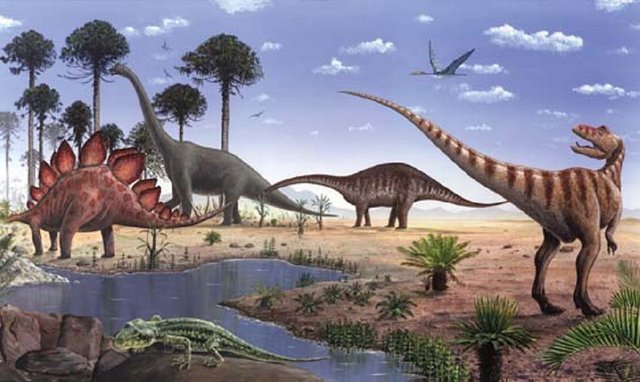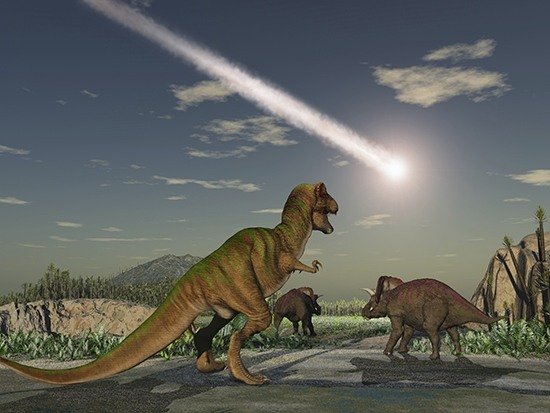Mesozoic Era: Age of the Dinosaurs

source
Amid the Mesozoic, or "Center Life" Period, life broadened quickly and mammoth reptiles, dinosaurs, and different massive monsters meandered the Earth. The period, which ranges from around 252 million years back to around 66 million years prior, was otherwise called the time of reptiles or the time of dinosaurs.
Limits
English geologist John Phillips, the main individual to make the worldwide geologic timescale, first instituted the term Mesozoic in the 1800s. Phillips discovered approaches to connect silt found the world over to particular eras, said Paul Olsen, a geoscientist at the Lamont-Doherty Earth Observatory at Columbia College in New York.
The Permian-Triassic limit, toward the beginning of the Mesozoic, is characterized in respect to a specific segment of dregs in Meishan, China, where a sort of wiped out, an eel-like animal is known as a conodont initially showed up, as per the Worldwide Commission on Stratigraphy.
The end limit for the Mesozoic Period, the Cretaceous-Paleogene limit, is characterized by a 20-inch (50 centimeters) thick fragment of shake in El Kef, Tunisia, which contains very much protected fossils and hints of iridium and different components from the space rock effect that wiped out the dinosaurs. The Mesozoic Time is isolated up into the Triassic, Jurassic, and Cretaceous periods.
Life and atmosphere
The Mesozoic Period started generally around the season of the end-Permian annihilation, which wiped out 96 percent of marine life and 70 percent of every single earthbound species on the planet. Life gradually bounced back, in the long run, offering a path to a thriving assorted variety of creatures, from gigantic reptiles to enormous dinosaurs.
The Triassic Timeframe, from 252 million to 200 million years back, saw the ascent of reptiles and the principal dinosaurs, the Jurassic Timeframe, from around 200 million to 145 million years prior, introduced flying creatures and well-evolved creatures, and the Cretaceous Timeframe, from 145 million to 66 million years prior is known for a portion of its notorious dinosaurs, for example, Triceratops and Pteranodon.
Coniferous plants, or those that have cone-bearing seeds, as of now existed toward the start of the period, yet they turned out to be considerably more bounteous amid the Mesozoic. Blossoming plants developed amid the late Cretaceous Timeframe. The rich vegetation amid the Mesozoic Time gave a lot of nourishment, permitting the greatest of the dinosaurs, for example, the Argentinosaurus, to grow up to 80 tons, as indicated by a recent report in the diary Revista del Museo Argentino de Ciencias Naturales.
Earth amid the Mesozoic Time was substantially hotter than today, and the planet had no polar ice tops. Amid the Triassic Timeframe, Pangaea still shaped one gigantic supercontinent. Absent much coastline to direct the landmass' inside temperature, Pangaea experienced significant temperature swings and was canvassed in substantial swaths of desert. However the area still had a belt of tropical rainforest in districts around the equator, said Brendan Murphy, an earth researcher at St. Francis Xavier College in Antigonish, Canada.
Terminations
The Mesozoic Time was bookended by two awesome eliminations, with another littler termination happening toward the finish of the Triassic Timeframe, Olsen said.
Around 252 million years prior, the end-Permian termination wiped out most life on Earth finished around 60,000 years, as indicated by a February 2014 examination in the diary Procedures of the National Foundation of Sciences (PNAS). Toward the finish of the Triassic Timeframe, about 201 million years prior, most land and/or water capable animals and crocodile-like animals that lived in the tropics were wiped out. Around 65 million years prior, a goliath space rock impacted into Earth and framed a monster pit at Chicxulub in the Yucatan Landmass.
Since the fossil record is inadequate, it's hard to state precisely what caused the annihilations, or even how quickly they happened. All things considered, certain species or hints of disastrous occasions could be absent in the fossil record basically in light of the fact that the dregs may have vanished more than a huge number of years, Olsen said.
"Nature is exceptionally effective at disposing of its bodies," Olsen revealed to Live Science.
Be that as it may, there are a couple of prime suspects in every one of the eliminations.
Toward the finish of the Permian, the Siberian Traps experienced huge volcanic emissions, which most geologists accept caused the world's greatest eradication. Precisely how, be that as it may, is begging to be proven wrong.
The volcanic ejections caused a spike in carbon dioxide in the climate, however, the 2014 PNAS ponder recommends that the spike was brief. The emissions may have expanded ocean surface temperatures and prompted sea fermentation that stifled out ocean life. Also, another investigation distributed in Walk 2014 in PNAS recommended that the emissions discharged immense troves of the component nickel, which energized a nourishing furor by nickel-chomping microorganisms known as Methanosarcina. Those microorganisms may have burped out gigantic measures of methane, superheating the planet.
Most researchers concur that a space rock effects wiped out the dinosaurs toward the finish of the Cretaceous Timeframe. The effect would have kicked up so much residue that it obstructed the sun, stopped photosynthesis, and prompted such an enormous disturbance in the evolved way of life that everything that wasn't a scrounger or little passed on.
Be that as it may, the Deccan Traps, in what is presently India, were heaving huge measures of magma both when the space rock effect and a couple of researchers trust these streams either specifically caused or quickened the dinosaurs' end.
Volcanism may likewise be at fault for the end-Triassic eradication. In spite of the fact that volcanism, by and large, prompts a worldwide temperature alteration, after an underlying volcanic ejection, colossal measures of sulfur heave into the air and cause a short time of worldwide cooling. Such cooling-warming cycles may have happened many occasions more than 500,000 years. Comparative cool spells have been attached to immense yield disappointments in chronicled times, for example, in Iceland in the 1700s, Olsen said.

source
Congratulations @shekhlab! You have completed the following achievement on the Steem blockchain and have been rewarded with new badge(s) :
Click on the badge to view your Board of Honor.
If you no longer want to receive notifications, reply to this comment with the word
STOPDo not miss the last post from @steemitboard:
@steemitboard thanks for your rewards